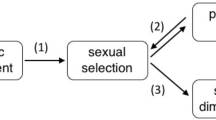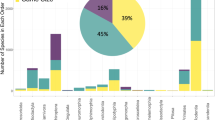Abstract
Arising from: Allsop, D. J. & West, S. A. Nature 425, 783–784 (2003); Allsop and West reply Organisms that change sex during their lifetime use a variety of strategies — they may be female first1, male first2 or even repetitive sex changers3. Natural selection should favour those individuals that change sex at a time when it increases their reproductive value4,5,6. Allsop and West7 claim that the relative timing of sex change is invariant across all animals, with individuals changing sex at 72% of their maximum body size, and infer that natural selection for sex change must therefore be fundamentally similar across animals. Here we explain why we believe that Allsop and West's claims are not supported by their analysis or by their empirical data7.
Similar content being viewed by others
Main
Inspection of the data underlying Allsop and West's results7,8 reveals that relative size at sex change (L50/Lmax) is highly variable (Fig. 1a). The basis for their claim of invariance is a tight relationship and a slope of unity when the average size at sex change (L50) is plotted against maximum size (Lmax)7. We suggest that the same relationship would hold if the average size at sex change were randomly distributed between Lmat, the size at maturity, and maximum size.
a, Distribution of relative size at sex change (L50/Lmax) for 52 species of fish used by Allsop and West7,8. b, Distribution of relative size at sex change for 77 hypothetical species generated by our null model. c, Log–log plot of average size at sex change (L50) against maximum size (Lmax) for 77 hypothetical species. The null data generate apparent invariance in relative size at sex change (b, c). d, Size at maturity (Lmat) plotted against maximum size: green circles, Lmat=33% Lmax; blue squares, Lmat=66% Lmax; red triangles, Lmat=100% Lmax. Average size at sex change must fall within these constraints. e, Log–log plot of the data shown in d. From d, e, it is evident that more stringent constraints generate more apparent invariance.
To test this idea, we developed a null model. Species were randomly assigned a maximum size (between 2 mm and 1.5 m)7, a size at maturity (assumed for simplicity to be 50% of their maximum size)9, and an average size at sex change between maturation and maximum size. We used this null model to generate 10 data sets with 77 species in each (Fig. 1b). This null model excludes only the factor of interest (the real distribution of size at sex change) while incorporating other realistic factors (such as a non-zero size at maturity) that might confound the results10.
Our regressions of log(L50) against log(Lmax) were indistinguishable from the regression found by Allsop and West7. Our analyses gave significant slopes ranging between 0.96 and 1.04, and explained 95–97% of the variation in size at sex change (Fig. 1c). Our results satisfy the criteria used to claim that the relative size at sex change is invariant7, even though the relative size at sex change is randomly distributed.
We repeated our analyses with a more realistic null model10 in which each species was randomly assigned a size at maturity of between 40% and 80% of its maximum size11, and found that this did not alter our conclusions. In this model, relative size at sex change develops a left skew like that seen in Fig.1a. Furthermore, the variance in L50/Lmax (mean±s.d.=0.018±0.003; n= 10 data sets) is indistinguishable from the variance found in the real data. The results of the null model of Gardner et al. (A. Gardner, E. Charnov, D. J. Allsop and S. A. West, manuscript in preparation) depend on the questionable assumption that size at maturity can range over 0–100% of maximum size. We conclude that Allsop and West's results7 do not demonstrate that relative size at sex change is invariant, and therefore that they offer no insight into natural selection for sex change.
These problems arise because size at maturity and maximum size constrain the set of possible values that average size at sex change may take (Fig. 1d). When the relationship between Lmax and L50 is plotted on a log–log scale, these constraints cause apparent invariance in L50 and a restriction in the range of possible slopes to values near 1.0 (Fig. 1e). As constraints on the attribute of interest become more stringent, it will generally become harder to reject the null hypothesis that the attribute is randomly distributed between the constraints.
Empirical data demonstrate that individuals change sex over a large range of sizes1,2,3. The timing of and size at sex change are often precisely linked to changes in relative condition and group membership1,2,3, suggesting that natural selection has shaped flexible sex-change strategies that are contingent on social context. To advance our understanding further we need to attend to the great variation in sex-change strategies within and among species.
References
Warner, R. R. & Robertson, D. R. Smithson. Contr. Zool. 254, 1–27 (1978).
Buston, P. M. Nature 424, 145–146 (2003).
Munday, P. L., Caley, M. J. & Jones, G. P. Behav. Ecol. Sociobiol. 43, 371–377 (1998).
Ghiselin, M. T. Q. Rev. Biol. 44, 189–208 (1969).
Warner, R. R. Am. Nat. 109, 61–82 (1975).
Charnov, E. L. The Theory of Sex Allocation (Princeton University Press, Princeton, 1982).
Allsop, D. J. & West, S. A. Nature 425, 783–784 (2003).
Allsop, D. J. & West, S. A. J. Evol. Biol. 16, 921–929 (2003).
Charnov, E. L. Life History Invariants (Oxford University Press, Oxford, 1993).
Gotelli, N. J. & Graves, G. R. Null Models in Ecology (Smithsonian Institution Press, Washington DC, 1996).
Beverton, R. J. H. J. Fish Biol. B 41, 137–160 (1992).
Author information
Authors and Affiliations
Corresponding author
Rights and permissions
About this article
Cite this article
Buston, P., Munday, P. & Warner, R. Sex change and relative body size in animals. Nature 428, 1 (2004). https://doi.org/10.1038/nature02512a
Issue Date:
DOI: https://doi.org/10.1038/nature02512a
This article is cited by
-
Factors influencing stoplight parrotfish territoriality and social structure in the middle Florida Keys
Environmental Biology of Fishes (2023)
-
Sex change as a survival strategy
Evolutionary Ecology (2020)
-
The relationship between sex change and reproductive success in a protandric marine gastropod
Scientific Reports (2016)
-
Relative size-at-sex-change in parrotfishes across the Caribbean: is there variance in a supposed life-history invariant?
Evolutionary Ecology (2011)
-
When is a male not a male? Sex recognition and choice in two sex-changing species
Behavioral Ecology and Sociobiology (2008)
Comments
By submitting a comment you agree to abide by our Terms and Community Guidelines. If you find something abusive or that does not comply with our terms or guidelines please flag it as inappropriate.




